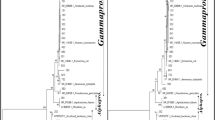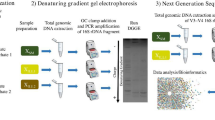Abstract
Performance of biological wastewater treatment systems may be related to the composition and activity of microbial populations they contain. However, little information is known regarding microbial community inhabiting these ecosystems. The purpose of this study was to investigate archaeal and bacterial diversity, using cultivation-independent molecular techniques, in a constructed wetland receiving domestic wastewater. Two 16S rRNA gene libraries were constructed using total genomic DNA and amplified by PCR using primers specific for archaeal and bacterial domains. A high microbial diversity was detected. The Proteobacteria phylum is the most abundant and diversified phylogenetic group representing 31.3 % of the OTUs, followed by the Bacteroidetes (14.8 %), Planctomycetales (13.8 %), Actinobacteria (12 %), and Chloroflexi (8.2 %). Sequences affiliated with minor phylogenetic divisions such as the TM7, Nitrospira, OP10, and BRC1 are represented by <6 % of total OTUs. The Archaea domain was represented by the Thaumarchaeota phylum dominated by the Candidatus Nitrososphaera genus.




Similar content being viewed by others

References
Alireza V, Kalyan R, Ghole VS (2009) A new approach in wetland systems for domestic wastewater treatment using Phragmites sp. Ecol Eng 35:1797–1803
Amann RI, Ludwig W, Schleifer KH (1995) Phylogenetic identification and in situ detection of individual microbial cells without cultivation. Microbiol Rev 59:143–169
An D, Wan-Taek I, Yang H, Lee S (2006) Shinella granuli gen. nov., sp. nov., and proposal of the reclassification of Zoogloea ramigera ATCC 19623 as Shinella zoogloeoides sp. Nov. Int J Syst Evol Microbiol 56:443–448
Artiguenave F, Wincker P, Brottier P, Dupart F, Scarpelli C, Verdier J, Vico V, Weissenbach J, Saurin W (2000) Genomic exploration of the hemiascomycetous yeast. 2. Data generation and processing. FEBS Lett 487:13–16
Björnsson L, Hugenholtz P, Tyson GW, Blackall LL (2002) Filamentous Chloroflexi (green non-sulfur bacteria) are abundant in wastewater treatment processes with biological nutrient removal. Microbiol 148:2309–2318
Caltheiros SC, Duque AF, Moura A, Henriques IS, Correia A, Rangel A, Castro PML (2009) Changes in the bacterial community structure in two-stage constructed wetlands with different plants for industrial wastewater treatment. Bioresour Technol 100:3228–3235
Chao A (1987) Estimating the population size for capture-recapture data with unequal catchability. Biometrics 43:783–791
Chen C, Ren N, Wang A, Liu L, Lee D (2010) Functional consortium for denitrifying sulfide removal process. Appl Microbiol Biotechnol 86:353–358
Chouari R, Le Paslier D, Daegelen P, Ginestet P, Weissenbach J, Sghir A (2005) Novel predominant archaeal and bacterial groups revealed by molecular analysis of an anaerobic sludge digester. Environ Microbiol 7:1104–1115
Collins G, O’Connor L, Mahony T, Gieseke A, de Beer D, O’Flaherty V (2005) Distribution, localization, and phylogeny, of Crenarchaeota in anaerobic granular sludge. Appl Environ Microbiol 71:7523–7527
De Santis TZ, Hugenholtz P, Larsen N, Rojas M, Brodie EL, Keller K, Huber T, Dalevi D, Hu P, Andersen GL (2006) Greengenes, a chimera-checked 16 S rRNA gene database and workbench compatible with ARB. Appl Environ Microbiol 72:5069–5072
DeLong EF (1992) Archaea in coastal marine environments. Proc Nat Acad Sci USA 89:5685–5689
Elshahed MS, Youssef NH, Spain AM, Sheik C, Najar FZ, Sukharnikov LO, Roe BA, Davis JP, Schloss PD, Bailey VL, Krumholz LR (2008) Novelty and uniqueness patterns of rare members of the soil biosphere. Appl Environ Microbiol 74:5422–5428
Fernandez N, Sierra-Alvarez R, Field JA, Amils R, Sanz JL (2008) Microbial community dynamics in a hemolithotrophic denitrification reactor inoculated with methangenic granular sludge. Chemosphere 70:462–474
Fesefeldt A, Kloos K, Bothe H, Lemmer H, Gliesche CG (1998) Distribution of denitrification and nitrogen fixation genes in Hyphomicrobium spp. and other budding bacteria. Can J Microbiol 44:181–186
Francis CA, Beman JM, Kuypers MM (2007) New processes and players in the nitrogen cycle: the microbial ecology of anaerobic and archaeal ammonia oxidation. ISME J 1:19–27
Fux C, Boehler M, Huber P, Brunner I, Siegrist H (2002) Biological treatment of ammonium-rich wastewater by partial nitritation and subsequent anaerobic ammonium oxidation (anammox) in a pilot plant. J Biotechnol 99:295–306
Good IJ (1953) The population frequencies of species and the estimation of population parameters. Biometrica 40:237–264
Griepenburg U, Ward-Rainey N, Mohamed S, Schlesner H, Marxen H, Rainey AF, Stackebrandt E, Auling G (1999) Phylogenetic diversity, polyamine pattern and DNA base composition of members of the order Planctomycetales. Int J Syst Bacteriol 49:689–696
Herrmann M, Saunders AM, Schramm A (2008) Archaea dominates the ammonia-oxidizing community in the rhizosphere of the freshwater macrophyte Littorella uniflora. Appl Environ Microbiol 74:3279–3283
Hicks RE, Amann RI, Stahl DA (1992) Dual staining of natural bacterio-plankton with 40, 6-diamidino-2-phenylindole and fluorescent oligonucleotide probes targeting kingdom level 16S rRNA sequences. Appl Environ Microbiol 58:2158–2163
Hughes JB, Hellmann JJ, Ricketts TH, Bohannan BM (2001) Counting the uncountable: statistical approaches to estimating microbial diversity. Appl Environ Microbiol 67:4399–4406
Lu S, Park M, Ro HS, Lee DS, Park W, Jeon CO (2006) Analysis of microbial communities using culture-dependent and culture-independent approaches in an anaerobic/aerobic SBR reactor. J Microbiol 44:155–161
Magurran AE (1996) Ecological diversity and its measurement. Chapman and Hall, London, pp 274–286
Mander Ü, Jenssen P (2003) Constructed wetlands for wastewater treatment in cold climates. WIT Press, Southampton
McHugh S, Carton M, Mahony T, O’Flaherty V (2003) Methanogenic population structure in a variety of anaerobic bioreactors. FEMS Microbiol Lett 219:297–304
Mechichi T, Stackebrandt E, Gad’on N, Fuchs G (2002) Phylogenetic and metabolic diversity of bacteria degrading aromatic compounds under denitrifying conditions, and description of Thauera phenylacetica sp. nov., Thauera aminoaromatic sp. nov., and Azoarcus buckelii sp. Nov. Arch Microbiol 178:26–35
Munch C, Kuschk P, Roske I (2005) Root stimulated nitrogen removal: only a local effect or important for water treatment. Water Sci Technol 51:185–192
Mußmann M, Brito I, Pitcher A, Damste JSS, Hatzenpichler R, Richter A, Nielsen JL, Nielsen PH, Müller A, Daims H, Wagner M, Head IM (2011) Thaumarchaeotes abundant in refinery nitrifying sludges express amoA but are not obligate autotrophic ammonia oxidizers. PNAS 108:16771–16776
Park HD, Wells GF, Bae H, Criddle CS, Francis CA (2006) Occurrence of ammonia oxidizing Archaea in wastewater treatment plant bioreactors. Appl Environ Microbiol 72:5643–5647
Schloss PD, Handelsman J (2005) Introducing DOTUR, a computer program for defining operational taxonomic units and estimating species richness. Appl Environ Microbiol 71:1501–1506
Schramm A, De Beer D, Wagner M, Amann R (1998) Identification and activities in situ of Nitrosospira and Nitrospira spp. as dominant populations in a nitrifying fluidized bed reactor. Appl Environ Microbiol 64:3480–3485
Shin G, Han G, Lim J, Lee C, Hwang S (2010) A comprehensive microbial insight into two-stage anaerobic digestion of food waste-recycling wastewater. Water Res 44:4838–4849
Spang A, Hatzenpichler R, Brochier-Armanet C, Rattei T, Tischler P, Spieck E, Streit W, Stahl DA, Wagner M, Schleper C (2010) Distinct gene set in two different lineages of ammonia-oxidizing Archaea supports the phylum Thaumarchaeota. Trends Microbiol 18:331–340
Stottmeister U, Wiesner A, Kuschk P, Kappelmeyer U, Kastner M, Bederski O, Muller RA, Moormann H (2003) Effects of plants and microorganisms in constructed wetlands for wastewater treatment. Biotechnol Adv 22:93–117
Tourna M, Freitag TE, Nicol GW, Prosser JI (2008) Growth, activity and temperature responses of ammonia-oxidizing Archaea and Bacteria in soil microcosms. Environ Microbiol 10:1357–1364
Tringe SG, von Mering C, Kobayashi A, Salamov AA, Chen K, Chang HW, Podar M, Short JM, Mathur EJ, Detter JC, Bork P, Hugenholtz P, Rubin EM (2005) Comparative metagenomics of microbial communities. Sci 308:554–557
Vacca G, Wand H, Nikolausz M, Kushk P, Kastner M (2005) Effect of plants and filter materials on bacteria removal in pilot-scale constructed wetlands. Water Res 39:1361–1373
Valenzuela-Encinas C, Neria-González I, Rocio J, Hernández A, Estrada-Alvarado I, de la Serna FJZ, Dendooven L, Marsch R (2009) Changes in the bacterial populations of the highly alkaline saline soil of the former lake Texcoco (Mexico) following flooding. Extremophiles 13:609–621
van Dongen U, Jetten MSM, Loosdrecht MCM (2001) The Sharon-Anammox process for treatment of ammonium rich wastewater. Wat Sci Tech 44:153–160
Verbaendert I, Boon N, De Vos P, Heylen K (2011) Denitrification is a common feature among members of the genus Bacillus. Syst Appl Microbiol 34:385–391
Vymazal J, Kröpfelová L (2005) Growth of Phragmites australis and Phalaris arundinacea in constructed wetlands for wastewater treatment in the Czech Republic. Ecol Eng 25:606–621
Yamamoto N, Otawa K, Nakai Y (2010) Diversity and abundance of ammonia-oxidizing bacteria and ammonia-oxidizing Archaea during cattle manure composting. Microb Ecol 60:807–815
Zhang CL, Ye Q, Huang Z, Huang Z, Li W, Chen J, Song Z, Zhao W, Bagwell C, Inskeep WP, Ross C, Gao L, Wiegel J, Romanek CS, Shock EL, Hedlund BP (2008) Global occurrence of archaeal amoA genes in terrestrial hot springs. Appl Environ Microbiol 74:6417–6426
Zhang CB, Wang J, Liu WL, Zhu SX, Ge HL, Chang SX, Chang J, Ge Y (2010) Effects of plant diversity on microbial biomass and community metabolic profiles in a full-scale constructed wetland. Ecol Eng 36:62–68
Zheng D, Alm EW, Stahl DA, Raskin L (1996) Characterization of universal small subunit rRNA hybridization probes for quantitative molecular microbial ecology studies. Appl Environ Microbiol 62:4504–4513
Acknowledgments
The authors are very grateful to technical assistance of the Genoscope sequencing and bioinformatics teams. We also thank the staff of the wastewater treatment plant in Ksour Essef (Tunisia) and the Tunis International Center for Environmental Technologies.
Author information
Authors and Affiliations
Corresponding author
Rights and permissions
About this article
Cite this article
Bouali, M., Pelletier, E., Chaussonnerie, S. et al. Characterization of rhizosphere prokaryotic diversity in a horizontal subsurface flow constructed wetland using a PCR cloning-sequencing based approach. Appl Microbiol Biotechnol 97, 4221–4231 (2013). https://doi.org/10.1007/s00253-012-4239-1
Received:
Revised:
Accepted:
Published:
Issue Date:
DOI: https://doi.org/10.1007/s00253-012-4239-1



